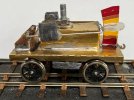Paul Townsend
Active Member
Olton Bridge model was built by the late Mike Jolly.
He bequeathed it to a chum who custodied it for many years but in return for services rendered offered it to me around 2013.
The timing was just right so I adapted my model design for Dartmouth in Broad Gauge c. 1875 to include it.
The prototype was a Brunel design for OWW Rly to cross a road at Olton near Bromsgrove. In the end Directors got cold feet and used a wrought iron bridge instead. The location exists today, line was quadrupled later on and a newer boring bridge is now in place.
In my fantasy world, the directors of Totnes and Dqartmouth Rly bought the drawings and had it built just north of Dartmouth to provide for the South Hams Rly to go below and bridge a stream. It would have been the last timber structure built using IKB's design.
The baseboards with this bridge and my foreground mixed gauge trackwork was entered into Scalefour North "18.83 Challenge" in 2014 at Wakefield and won the Eileen's Emporium award for best scratch-build in the show. So that was partly for my track and partly in memorium to Mike Jolly.
He bequeathed it to a chum who custodied it for many years but in return for services rendered offered it to me around 2013.
The timing was just right so I adapted my model design for Dartmouth in Broad Gauge c. 1875 to include it.
The prototype was a Brunel design for OWW Rly to cross a road at Olton near Bromsgrove. In the end Directors got cold feet and used a wrought iron bridge instead. The location exists today, line was quadrupled later on and a newer boring bridge is now in place.
In my fantasy world, the directors of Totnes and Dqartmouth Rly bought the drawings and had it built just north of Dartmouth to provide for the South Hams Rly to go below and bridge a stream. It would have been the last timber structure built using IKB's design.
The baseboards with this bridge and my foreground mixed gauge trackwork was entered into Scalefour North "18.83 Challenge" in 2014 at Wakefield and won the Eileen's Emporium award for best scratch-build in the show. So that was partly for my track and partly in memorium to Mike Jolly.


